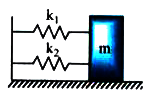The amplitude and time period of a particle of mass 0.1 kg executing simple harmonic motion are 1m and 6.28s, respectively. Find its (i) angular frequency, (ii) acceleration and (iii) velocity at a displacement of 0.5 m.Solution in Telugu
√32ms−1
Topper's Solved these Questions
- OSCILLATIONBOOK - AAKASH SERIESCHAPTER - OSCILLATIONEXERCISE - NUMERICAL EXERCISE (LEVEL-2)
37 Videos
- OSCILLATIONBOOK - AAKASH SERIESCHAPTER - OSCILLATIONEXERCISE - QUESTIONS FOR DESCRIPTIVE ANSWERS
12 Videos
- OSCILLATIONBOOK - AAKASH SERIESCHAPTER - OSCILLATIONEXERCISE - VERY SHORT ANSWER TYPE QUESTIONS
31 Videos
- NEWTONS LAWS OF MOTION BOOK - AAKASH SERIESCHAPTER - NEWTONS LAWS OF MOTION EXERCISE - ADDITIONAL PRACTICE EXERCISE PRACTICE SHEET (ADVANECED) (Matrix Matching Type Questions)
1 Videos
- OSCILLATIONSBOOK - AAKASH SERIESCHAPTER - OSCILLATIONSEXERCISE - PRACTICE EXERCISE - SPRINGS
16 Videos
Similar Questions
Find the time period of the oscillation of mass m in figure. What is the equivalent spring constant of the pair of springs in each case ?

View SolutionThe spring shown in figure is unstretched when a man starts pulling on the cord. The mass of the block is M. If the man exerts a constant force F, find the amplitude and the time period of the motion of the block.

View SolutionGive two examples of periodic motion which are not oscillatory ?
View SolutionThe system shown in the figure is given an acceleration 'a' towards left. Assume all contact surfaces to be smooth (m: mass of the sphere) The magnitude of the contact force between wedge and sphere between wedge and sphere at A is xmg√3 then 'x' is

View SolutionA ball of mass 2kg hanging from a spring oscillates with a time period 2p seconds. Ball is removed when it is in equilibrium position, the spring shortens by
View SolutionThe acceleration displacement graph of a particle executing simple harmonic motion is shown in figure. The time period of simple harmonic motion is
View SolutionThe amplitude and time period of a aprticle of mass 0.1kg executing simple harmonic motion are 1m and 6.28s , respectively. Then its angular frequency and acceleration at a displacement fo 0.5m are respectively
View SolutionA particle executing simple harmonic motion with amplitude of 0.1 m. At a certain instant when its displacement is 0.02 m, its acceleration is 0.5 m/s 2. The maximum velocity of the particle is (in m/s )
View SolutionA particle of mass 10grams is executing simple harmonic motion with an amplitude of 0.5 m and periodic time of )(π/5)seconds . The maximum value of the force acting on the particle
View SolutionA particle executes simple harmonic motion. The amplitude of vibration of particle is 2 cm. The displacement of particle in one time period is
View SolutionA particle executing simple harmonic motion with an amplitude 5 cm and a time period 0.2 s. the velocity and acceleration of the particle when the displacement is 5 cm is
View SolutionDerive expressions for displacement, velocity and acceleration of a particle executing simple harmonic motion.
View SolutionA particle executing simple harmonic motion with amplitude of 0.1 m. At a certain instant when its displacement is 0.02 m, its acceleration is 0.4 m/s2. The maximum velocity of the particle is (in m/s)
View Solutionएक कण सरल आवर्त गति कर रहा है , इसका आयाम 0.1 मी है, एक निश्चित समय पर इसका विस्थापन 0.02 तथा इसका त्वरण 0.5मी/से2 है कण का महत्तम वेग (मी//से)
View SolutionThe amplitude and time period of a particle of mass 0.1 kg executing simple harmonic motion are 1m and 6.28s, respectively. Find its (i) angular frequency, (ii) acceleration and (iii) velocity at a displacement of 0.5 m.
View SolutionThe amplitude and time period of a particle of mass 0.1 kg executing simple harmonic motion are 1m and 6.28s, respectively. Find its (i) angular frequency, (ii) acceleration and (iii) velocity at a displacement of 0.5 m.
View Solution
